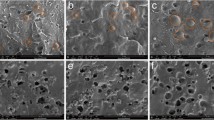Abstract
The polyethylene insulation material can be affected by thermal factor in the process of manufacture and operation, resulting in irreparable minor structural damage. The damage can distort electric field, which seriously threatens the operation of power grid. In this paper, the thermal properties of self-healing polyethylene insulation composites were analyzed to reduce the damage of thermal factor on the performances of polyethylene. Moreover, the thermal properties of microcapsules with different process ratio and heat treatment were tested. Furthermore, the self-healing performance to physical structural damage was verified by scratch test. The results show that the short-term stability temperature of microcapsule is about 215 °C, and its performance is better when the core-wall ratio is about 0.5. In the long-term thermal environment, the microcapsule can maintain the full morphology below 120 °C and the complete core-wall structure below 180 °C. The damage of thermal factor to microcapsule is mainly reflected in the loss of core material and the rupture of wall structure. Compared with pure polyethylene, the composite has obvious self-healing ability for physical structural damage. Moreover, the thermal decomposition temperature, resistivity and crystallinity of composite are higher, which mainly related to the characteristics of interface between microcapsule and polyethylene. Furthermore, the initial pyrolysis temperature of composite is decreased due to the relatively low thermal stability of microcapsule. In general, the thermal properties of microcapsule can meet the polyethylene application requirements. Moreover, the performances of composite can meet the operation and self-healing requirements of polyethylene insulation material at high temperature.
Access this chapter
Tax calculation will be finalised at checkout
Purchases are for personal use only
Similar content being viewed by others
References
Li, J., Zhang, J., Li, Q., et al.: Thermal aging effects on fire performance of the cross-linked polyethylene insulated cable. Mater. Sci. Forum 898, 2399–2404 (2017)
Yang, Y., He, J., Li, Q., et al.: Self-healing of electrical damage in polymers using superparamagnetic nanoparticles. Nat. Nanotechnol. 14(2), 151 (2019)
Borisova, M.E., Osina, Y.K.: The influence of thermal aging on absorption phenomena in cross-linked polyethylene cable insulation. Tech. Phys. Lett. 43(1), 136–138 (2017)
Zhou, L., Qiu, Q., Cheng, R., et al.: Propagation and partial discharge characteristics of electrical trees in XLPE Cable under high temperatures and high gas pressures. High Voltage Eng. 44(5), 1421–1427 (2018)
Huang, M., Zhou, K., Yang, D., et al.: Effect of on-line rejuvenation on water tree propagation in XLPE cables. Trans. China Electrotech. Soc. 31(21), 176–182 (2016)
Bekas, D.G., Tsirka, K., Baltzis, D., et al.: Self-healing materials: a review of advances in materials, evaluation, characterization and monitoring techniques. Compos. B Eng. 87, 92–119 (2016)
Khaliq, W., Ehsan, M.B.: Crack healing in concrete using various bio influenced self-healing techniques. Constr. Build. Mater. 102(1), 349–357 (2016)
White, S.R., Sottos, N.R., Geubelle, P.H., et al.: Autonomic healing of polymer composites. Nature 409(6822), 794–797 (2001)
Arshad, M.A., Maaroufi, A.K., Benavente, R., et al.: Kinetics of the thermal degradation mechanisms in urea-formaldehyde cellulose composites filled with zinc particles. J. Mater. Sci.: Mater. Electron. 28(16), 11832–11845 (2017)
Fereidoon, A., Ghorbanzadeh Ahangari, M., Jahanshahi, M.: Effect of nanoparticles on the morphology and thermal properties of self-healing poly(urea-formaldehyde) microcapsules. J. Polym. Res. 20(6), 151 (2013)
Wang, Y., Wang, C., Zhang, Z., et al.: Effect of nanoparticles on the morphology, thermal, and electrical properties of low-density polyethylene after thermal aging. Nanomaterials 7(10), 320 (2017)
Zhang, X., Ji, H., Qiao, Z.: Residual stress in self-healing microcapsule-loaded epoxy. Mater. Lett. 137, 9–12 (2014)
Yuan, L., Liang, G., Xie, J., et al.: Thermal stability of microencapsulated epoxy resins with poly (urea–formaldehyde). Polym. Degrad. Stab. 91(10), 2300–2306 (2006)
Murphy, E.B., Wudl, F.: The world of smart healable materials. Prog. Polym. Sci. 35(1), 223–251 (2010)
Zhang, X., Shi, Z., Li, L., et al.: Crystallization behavior and electrical tree resistance property of montmorillonite-SiO2/Low density polyethylene composite. Acta Materiae Compositae Sinica 35(11), 122–131 (2018)
Cha, H., Wu, A., Kim, M.K., et al.: Nanoscale-agglomerate-mediated heterogeneous nucleation. Nano Lett. 17(12), 7544–7551 (2017)
Zhang, P., Cao, D., Cui, S.: Resistivity-temperature behavior and morphology of low density polyethylene/graphite powder/graphene composites. Polym. Compos. 35(8), 1453–1459 (2014)
Dai, J., Yan, H., Gou, J., et al.: Effects of crystallinity on degradation properties of polyethylene by thermo-oxidation aging. Chin. J. Mater. Res. 31(1), 41–48 (2017)
Acknowledgments
The reported research was performed due to the National Natural Science Foundation of China. The contract grant number: 51777018.
Author information
Authors and Affiliations
Corresponding author
Editor information
Editors and Affiliations
Rights and permissions
Copyright information
© 2020 Springer Nature Switzerland AG
About this paper
Cite this paper
Li, Y., Wang, Y., Zhang, Y., Zhang, Z. (2020). Thermal Properties of Self-healing Polyethylene Insulation Composites Based on Microcapsule System. In: Németh, B. (eds) Proceedings of the 21st International Symposium on High Voltage Engineering. ISH 2019. Lecture Notes in Electrical Engineering, vol 599. Springer, Cham. https://doi.org/10.1007/978-3-030-31680-8_4
Download citation
DOI: https://doi.org/10.1007/978-3-030-31680-8_4
Published:
Publisher Name: Springer, Cham
Print ISBN: 978-3-030-31679-2
Online ISBN: 978-3-030-31680-8
eBook Packages: EngineeringEngineering (R0)




